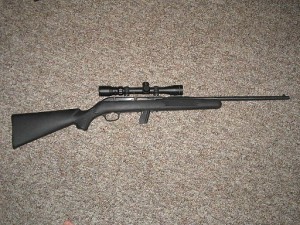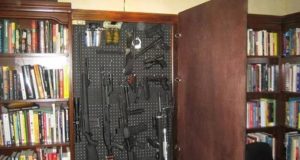In part one we took a look at the breakdown/takedown options, but there is more to the game than just the semi-auto “short stuff” players we already explored. We now welcome to the arena the bolt actions with a tactical edge and those that seek to maintain the sleek classic lines from yesteryear’s famous rifles.
 The Savage 64
The Savage 64
The Savage 64 is obviously not a bolt action, tactical or otherwise; it’s also a semi auto, but it gets honorable mention prior to listing the other excellent offering from Savage (below).
The point here is that they have elevated the game for all makers by producing guns that are at par or are better appointed than other major manufacturers at a significantly lower price point. So either way you look at it, the Savages will deliver on your expectations, and usually will drastically exceed them.
What you get is an incredibly tough, inexpensive semi-auto, capable of killing things. It starts at around $165 and goes up to about $315, depending on the configuration. Many of the variants get tactical, with options like picatinny rails and threaded muzzles, but without question, it’s one of the more customizable guns from factory. Wood, polymer, stainless steel, blued, threaded muzzle, different sized magazines and tactical appointments: it’s all up to you. On top of that, the rifle weighs in at around 6.5 pounds, making it one of the more substantial .22 rifles on the market in its niche.
Savage Mark II FVSR
This gun gets special mention as one of the coolest guns to hit the .22LR arena in a long time. It’s built with the user in mind and has a mind for being an overachiever.
It’s a bolt-action rifle, shoots simple and reliable magazines (five shots), and drives tacks—in other words, it’s ridiculously accurate). It’s cheap (under $250), durable, has an adjustable trigger and a threaded barrel end for accepting a suppressor, and it’s lightweight at around five pounds or so.
You won’t have to worry too much about having replacement parts on hand, except maybe the normal firing pin, a couple springs, and an extractor, because as a bolt action, it isn’t as subject to failure as some other designs.
It does everything that the Ruger 10-22 does, except it’s not semi-auto (sometimes desirable) and the magazines aren’t quite as nice as the rotary mags from Ruger.
If you might want the option of putting a “can” on the end of your rifle, this is the one, because the bolt action allows you to feed the subsonic quiet ammunition reliably, and the durability and feel is excellent.
How To Defend Yourself And Your Family Against The New Breed Of Lowlife Criminal Scum
Remington 597
What list would be complete without a Remington rifle on it? Certainly not this one.
What makes this gun so special, aside from the obvious reputation it enjoys? It all comes down to the clean lines, smooth functionality, and the history of excellent service without breakage. Oh yeah, and it’s very accurate, smooth pointing, and reliable to boot. It’s about $250, well within the range of an “inexpensive” rifle, and yet it still delivers more than its value. It’s not as pretty as the original blue and wood guns Remington was making in the 1960s and 1970s, but it has its own unique and lovely looks on its own. Besides that, there is something to be said for beauty by virtue of reliability when it comes to guns. The Remington has everything a beginner’s guns should have, with nothing extraneous. It’s purely about functionality with the 597, and it delivers impressive marks in all categories.
Marlin Model 60
Another honorable mention, the Marlin Model 60 is the original 22LR rifle. If there is a gun more well-known than the Ruger 10-22 and Remington 597, then it surely must be the Marlin Model 60. It was the original high capacity (eighteen rounds), original target model fun gun, original reliability champion; it’s perhaps the one .22 that started it all, depending on who you ask. 12 million Marlin 60 owners cannot be wrong, surely. It has simple clean lines with an under barrel, tubular magazine that helps to mitigate potential feeding concerns or lost magazine issues. There have been Marlins which have fired with thousands of rounds gone through them with an almost disregard to the fouling and debris that is commonly an issue in small-caliber firearms. If there is a more dirt/grime-tolerant firearm on the planet, it would be surprising, as this Marlin 60 has a history of going months without cleaning and still being capable of dispatching an animal or two.
Ready for the dealmaker? The gun can often be found for $130 on special, and it has a “normal” price range of under $175 or so. That’s impressive considering the reputation that the Marlin Model 60 enjoys in the eyes of so many.
So what’s the conclusion about rifles that are ready for the end of days?
Firstly, no one will ever agree with a single platform from which to stage a resistance/survival attempt/attack, but given all the various needs arising in an apocalyptic scenario, there are few if any platforms, calibers, or styles more adept at handling themselves than the venerable .22LR. Surely, many of the readers of this article will immediately disagree in favor of a 9 mm Glock, a 308 M1 Garand, a 5.56 AR variant, or a 12-gauge shotgun (or others), but long after I have spent the stockpile of 12 gauge, .223, or .308, I may still be able to stay alive because I spent $500 on .22LR ammunition and another $250 on a good trusty rifle. It’s not what you ask it to do that counts; it’s how well it performs when you ask it to. Sure, I can kill people or large game more easily with a .308 that has a $5,000 scope on it, but how many of those would I theoretically need to focus on? If I had my choice in a situation that threatens my legacy, my family, or my own life, I prefer to have more. More is better when more is a .22LR, and not something less versatile. If anything, at least regard the humble .22LR as a perfect beginning point in your preparation for an end-of-days scenario; millions like you already do.
©2012 Off the Grid News
 Off The Grid News Better Ideas For Off The Grid Living
Off The Grid News Better Ideas For Off The Grid Living




